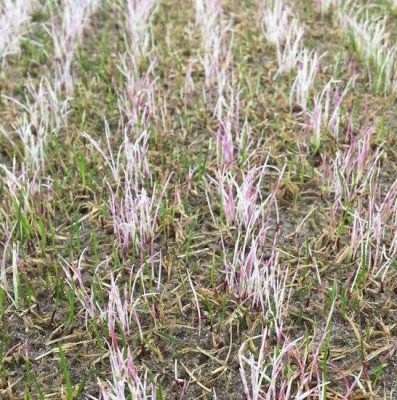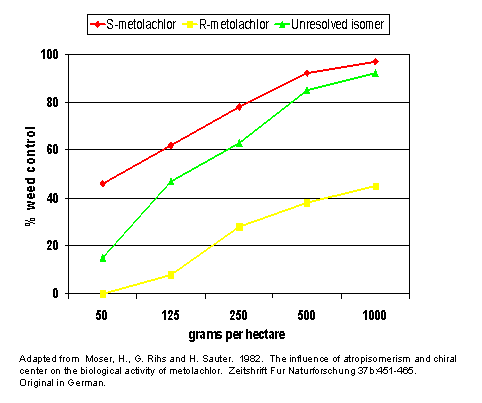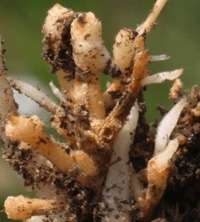In this blog we cover: What is a pre-emergent herbicide, How do pre-emergents work, How to use pre-emergent herbicides, When to apply pre-emergent herbicides and What is the best pre emergent herbicide.
What is a Pre-emergent herbicide?
A pre-emergent herbicide is a weed killer that prevents weeds from establishing. As their name implies, the best time to use pre-emergent herbicides is before weeds appear.
A post-emergent herbicide like the sulfonylurea, Recondo herbicide, kills weeds when they are already present. The key to using pre-emergents is to know how they work and then behave once they are in the soil. If you don’t do this you will get poor results.
In the above image, ryegrass is affected by the pre-emergent diflufenican whilst still active in the soil. This is an example of when not to apply a pre-emergent herbicide
Our recent turf blogs cover factors effecting herbicide performance, split applications of pre-emergents and reasons for pre-emergent failure.
How do Pre-emergent herbicides work?
Pre-emergent weed killers have zero effect on weed seeds. Instead, they prevent germinated weed seedlings from establishing by forming a barrier at the soil surface.
Hence, you need to apply pre-emergents before weeds germinate. Most pre-emergents act on weed roots except for oxadiazon, which acts on seedling shoots and is the only shoot active pre-emergent for use in turf. Oxadiazon is the active in Echelon® and Echelon Duo®.
To work, you must wash the chemical into the soil. It must also be present when the weed seeds germinate, as you need soil moisture to enable these to work.
Once inside plants, their movement varies. Some pre-emergent herbicides move in the xylem, and some through the phloem. Others are contacts that affect the entry point.
How well a pre-emergent herbicide works, is effected by the formulation, rainfall, temperature, timing, and soil type.
Pendimethalin.
The pre-emergent herbicide pendimethalin works on root tips and is a “root pruner”. It needs to be watered into the rootzone to work well.
Prodiamine.
As a pre-emergent herbicide, prodiamine works when you water it into the root zone. It is a “root pruner”, and little moves within the plant.
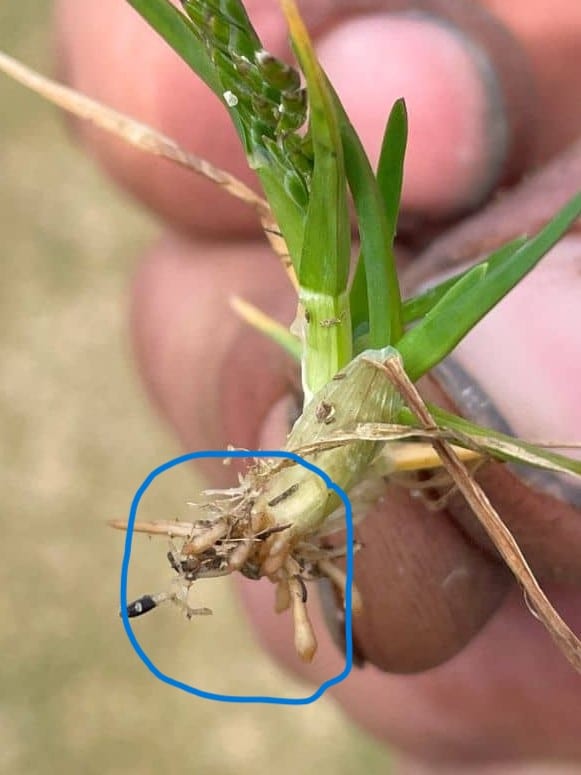
Oxadiazon.
Oxadiazon, works in a unique way as a pre-emergent herbicide. It acts on seedling shoots as they grow through the treated soil.
Dithiopyr.
Dithiopyr is a mitotic inhibitor, and even though it is a pre-emergent herbicide, it also works as an early post-emergent herbicide.
Metolachlor.
Metolachlor, works as a pre-emergent herbicide, mainly for annual grass and broadleaf weeds. It enters through leaves and shoots meaning you can apply it in lower water volumes than many other pre-emergent herbicides.
Dimethenamid-p Herbicide.
Dimethenamid-p herbicide controls a number of broadleaf and grass weeds for 6 to 8 weeks. This works by inhibiting Photosystem II, part of the photosynthesis pathway. It controls annual grasses, annual sedges, spurge, oxalis, doveweed, willowherb and many others. It suppresses Yellow Nutgrass, but does not control Purple Nutsedge, Evening Primrose, Morning Glory, or Pearlwort.
Are Pre-emergents Safe?
Turf chemicals can be dangerous to humans, animals and the environment if you don’t follow the label. Therefore, when you use turf chemicals, follow the manufacturer’s directions. Remember, as you’re the one using them, it means you are liable. Having said that, if you follow the label, these products are safe to use.
The term acute toxicity is the amount of active required to kill 50% of a population. Acute toxicity is expressed, as LD50 (lethal dose 50). The lower the LD50, the greater its toxicity to humans and animals. Chemicals with a high LD50 are the least toxic. For example, caffeine has an LD50 of 200mg/kg. In contrast, the LD50 of prodiamine, the active in Barricade herbicide, is >5000mg/kg. The table below shows the LD50 of common pre-emergents.
When to Use a Pre-emergent Herbicide.
As a rule, if you see weeds your too late, so its worth to always closely check in the turf canopy too see if any weeds are germinating. Often weeds are present but are hidden due to close mowing. The aim or pre-emergents, is to create a barrier to weeds before they germinate. Howevre, there are exceptions to this.
The best example of this is Dimension herbicide, which gives great pre and post emergent control of a range of grasses and broadleaf weeds in turf.
Pre emergent turf herbicide mode of action table | ||
Chemical Group | Active (Trade name) | LD 50 Oral |
3 | ||
Inhibition of microtubule assembly | ||
Benzamides | propyzamide (Proforce Checkpoint®*500SC) | 5,620 |
DNA's | pendimethalin (Proforce Battalia®) | 1,250 |
prodiamine (Barricade® herbicide) | > 5,000 | |
Pyridines | dithiopyr (Dimension®) | > 5,000 |
12 | ||
PDS inhibitors | ||
Phenyl-ethers | diflufenican (Warhead Trio®*) | > 2,000 |
14 | ||
PPO inhibitors) | ||
N-Phenyl-oxadiazolones | oxadiazon (Echelon®, Oxafert®) | > 5,000 |
15 | ||
VLCFA inhibitors | ||
α-Chloroacetamides | dimethenamid (Freehand®*) | 849 |
S-metalochlor (Pennmag®) | 2,780 | |
Benzofurans | ethofumesate (Tramat®) | > 20,000 |
29 | ||
Inhibition of cellulose biosynthesis | ||
Alkylazines | indaziflam (Specticle®) | > 2,000 |
When not to use Pre-emergents.
What condition your turf is in when you apply a pre-emergent is the main factor that influences the timing. Do not use pre-emergents:
- On thin turf under stress.
- If it has a weak root system.
- If you are going to seed. If you are plan to seed or renovate, then think carefully before using these.
There are several factors to consider as to how well a pre-emergent performs:
- Its solubility;
- How well it binds to soil particles;
- The weather conditions when you use it, and finally
- The use rate.
- The weed history of a site as this helps in your choice of which pre-emergent to use. There is little point in using a pre-emergent if it doesn’t work against the target weed.
The following is a summary of these factors. Always remember that pre-emergents don’t all behave the same!
Factors that affect Pre-emergents.
Volatilization.
Some pre-emergents are prone to volatilization. This means that if they remain on the soil surface, they turn into a gas and evaporate. Evaporation is greatest under windy, hot temperatures. The table below shows how likely common pre-emergents are to volatilize. Those at the top are more likely to volatilize in comparison to those at the bottom.
You have to water in pre-emergents with high vapour pressure like Pennmag® as soon as you apply them, because as soon as the spray dries losses begin. On the other hand, products with a low vapour pressure like Specticle® do not need immediate watering and can be left for up to 21 days.
In brief, labels with a water-in period are the time after which losses may start to become too high. However, losses will occur before that time.
The best pre-emergent herbicide to use if water is an issue: Envu Specticle.
Vapour pressure for common pre-emergent herbicides | ||
s-metolachlor (Pennmag) | 3.7 | Actives with a vapour pressure of greater than 1mPa are generally considered volatile. |
pendimethalin (Battalia) | 3.34 | |
dimethenamid-P (Freehand) | 2.5 | |
oxadiazon (Ronstar/Echelon) | 0.67 | |
terbuthylazine (Numchuk Quad) | 0.152 | Actives with a vapour pressure of less than 1mPa are generally considered non-volatile |
propyzamide (Rustler) | 0.058 | |
Prodiamine (Barricade/Onset 10GR) | 0.0033 | |
diflufenican (Warhead) | 4.25 x 10-3 | |
Indaziflam (Specticle) | 2.5 X 10-05 | |
Oryzalin (Prolan) | 1.1 X 10-07 | |
The Persistence of Pre-emergents.
DT50 Value.
- The soil type.
- The environmental conditions, and
- The rate of use.
DT50* values for pre-emergent herbicides | ||
DT50 Value | ||
dimethenamid-P (Freehand) | 7 | |
s-metolachlor (Pennmag) | 21 | |
terbuthylazine (Numchuk Quad) | 22 | 0 to 30 Non persistent |
dithiopyr (Dimension) | 39 | |
Oryzalin (Prolan) | 44.8 | 30 to 100 Moderately persistent |
propyzamide (Rustler) | 60 |
|
pendimethalin (Battalia) | 100 | |
diflufenican (Warhead) | 105 | |
prodiamine (Dimension/Onset 10GR) | 120 | >100 Persistent |
indaziflam (Specticle) | 150 | |
oxadiazon (Ronstar/Echelon) | 502 | Very persistent |
Water.
The uptake of most pre-emergents is via the roots, and this means that to work effectively there has to be good soil moisture present.
If the soil is too dry, there will be limited uptake, and the product will fail. Watering also causes weed seeds to germinate which is important to ensure that pre-emergents work.
The table below shows the solubility of turf pre-emergents. Pre-emergent solubility does not mean how easily the product dissolves. Instead it is the highest concentration that can dissolve in a volume of water. For instance, some chemicals easily dissolve but have low solubility. Others are difficult to dissolve but have a high solubility.
Herbicides with low solubility need larger water volumes to wash them into the soil and good soil moisture for the length of control. This is in contrast to high solubility pre-emergents that are easy to water in.
Solubility of common pre-emergent herbicides. | ||
diflufenican (Warhead) | 0.05 | |
Prodiamine (Barricade/Onset 10GR) | 0.013 | |
pendimethalin (Battalia) | 0.33 | |
oxadiazon (Ronstar/Echelon) | 0.57 | |
Oryzalin (Prolan) | 1.13 | |
Dithiopyr (Dimension) | 1.38 | Low solubility (0 to 49mg/L @ 20C). Likely to require moist conditions for incorporation and uptake. |
Indaziflam (Specticle) | 2.8 | |
terbuthylazine (Numchuk Quad) | 7 | |
propyzamide (Rustler) | 9 | |
s-metolachlor (Pennmag) | 480 | High solubility (> 501mg/L @ 20C). |
dimethenamid-P (Freehand) | 1499 | |
Flooding.
When a soil becomes waterlogged, oxygen is depleted, and this creates an anaerobic environment. These soils can result in what is termed accelerated anaerobic herbicide dissipation. This can cause weed breakthrough to occur after preemergent herbicides have prematurely degraded below effective concentrations.
Table of Soil Moisture Effects on pre-emergent Herbicide Longevity.
Active Ingredient | Trade Name | Half Life in Moist Soil (Days) | Half Life in Saturated Soil (Days) |
Indaziflam | Specticle | 120 | 120 |
Metolachlor | Pennmag | 80 | 50 |
Oxadiazon | Ronstar | 60 | 30-60 |
Pendimethalin | Battalia | 45 | 12 |
Prodiamine | Barricade | 56 | 28 |
Soil Properties.
Organic matter and soil texture affect how these behave in the soil. Clay soils and high organic matter soils will “tie up” more chemicals than sandy soils. This means that you then need higher rates to give the same level of control. The higher rates account for the fact that less is available for weeds to take up as more is locked up in those soil types.
Reasons for higher chemical movement out of a rootzone:
- High sand-content soils are unable to hold onto any chemicals.
- In low organic matter soils, less herbicide is likely to become “tied up”.
- Physical movement occurs on slopes and areas of thin turf cover where water moves.
The sorption coefficient (Koc) measures how much a chemical binds to soils.
Chemicals that have a high Koc, tend to bind tightly to soil and organic matter, for example, pendimethalin.
Low Koc herbicides, for example, metolachlor, are less likely to bind to clay or high organic matter soils and tend to be mobile in the soil.
Ranking of Pre-emergent binding to Organic Matter.
If we rank pre-emergents from those least likely to bind to those with the highest binding: Metalochlor < Dithiopyr < Oxadiazon < Pendimethalin = Prodiamine.
The best pre-emergent herbicides to use in high organic matter soils: Pennmag herbicide SDS or Meteor herbicide (metalochlor)
Average adsorption coefficients for common pre-emergent herbicides. | |||
pendimethalin (Battalia) | 17491 | Koc > 4000 | Likely to bind tightly to soil and organic matter |
Prodiamine (Barricade/Onset 10GR) | 12710 | Non-mobile. | |
oxadiazon (Ronstar/Echelon) | 3200 |
| |
diflufenican (Warhead) | 1622 | ||
indaziflam (Specticle) | 1000 | Koc 500 to 4000 slightly mobile |
|
oryzalin (Prolan) | 949 |
| |
propyzamide (Checkpoint) | 840 | ||
dithiopyr (Dimension) | 801 |
| |
terbuthylazine (Numchuk Quad) | 230 | Koc 75 to 500 moderately mobile |
|
dimethenamid-P (Freehand) | 218 | ||
s-metolachlor (Pennmag) | 200 | Koc 15 to 75 Mobile | |
Chemical Breakdown of Pre-emergents.
Breakdown in soils is a result of microbes and chemical hydrolysis. Several soil factors impact the speed at which this occurs:
- Soil temperatures. The higher the soil temperature, the faster the breakdown.
- Soil moisture. In moist soils, breakdown is quicker than in dry soils.
- Adequate soil oxygen and nutrients, speed up this decay.
- A neutral soil pH.
| Herbicide | Soil Texture and Organic Matter | Soil pH | Soil moisture and Temperature |
| Dimethenamid-p (Freehand®) |
|
Not a factor | Soluble and may leach in sandy soils after heavy rainfall |
| S-metalochlor (Pennmag®) |
|
Not a factor | Soluble, but less soluble than Dimethenamid-p and so has a less activity |
Poor Pre-emergent Herbicide Timing.
Poor timing has a big impact on any results, and in our opinion, this is the main reason for product failures. So, let’s clear something up. If you see weeds, it is generally too late to use a pre-emergent.
The table below shows critical soil temperatures for several common grass weeds (at 10cm depth) courtesy of North Carolina State University.
| Weed | Temperature °C |
| winter grass/ Winter grass | 21 |
| Crowsfoot | 16-18 |
| Summergrass | 12-15 |
| Knotweed | 2-10 |
Crowsfoot germinates at a higher temperature than summer grass and tends to germinate 2 to 8 weeks later than summer grass in the Spring. Knotweed germinates even earlier.
This means that if you plan to make a pre-emergent Crowsfoot application, a smart move is to make this around 2 weeks after you first see signs of Summer Grass.
However, some products have a wider application window, such as Dimension® herbicide. Dimension controls Summer Grass before it germinates and in the early post-emergent stage.
This means you can apply later and still get control.
Another example is Specticle® herbicide, which has pre and post-emergent activity against Winter Grass, although work needs to be done on the effects of plant size on the results. The image below, shows the effects of Specticle® against winter grass in couch fairways.
Best pre-emergent herbicide for a flexible timing window: Dimension herbicide
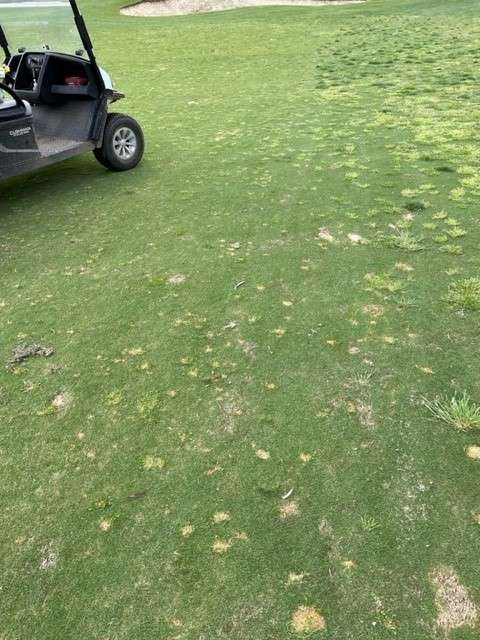
Photodegradation.
Photodegradation is the breakdown of chemicals due to the action of sunlight on the soil surface. Yellow-coloured herbicides, like prodiamine and pendimethalin, all decay in sunlight if you do not water them in after you apply them.
How to Get the best results:
These are some general tips to give you a better chance of getting great results:
Calibrate your equipment.
Correct calibration is vital if you use a granular or liquid pre-emergent herbicide. Fail to do this, and it means you will make an uneven application and you’ll get poor results.
Choosing Pre-emergents on price.
If you always buy on price alone it never guarantees good results. Instead, you should select the right product for your situation. There are five factors to consider:
- What weeds do you want to control? Different products work better on different weeds. The low cost option might not even work on your target weed.
- How much does an application cost? Consider factors such as rate, length of control and pack size.
- What is your turf type? Not all products are safe on all turf types. There isn’t much point if you buy the cheapest product on the market and it’s going to kill your turf.
- When you make a purchase, did you buy it from a supplier who can give you good agronomic advice on how to get the best results?
- How long do you want it to last? Longer control isn’t always the best if for example, you want to seed later.
- If the actives are the same, look at how easy it is to apply and handle. For instance, both Barricade® herbicide and Onset 10GR® contain the same active, but one is a liquid and the other a granule.
Table Showing Pre-emergent Herbicide Groups, Cost/Ha and Longevity.
Product | AI | FRAC Group | Rate per Ha | African Love grass | Annual Rye | Crabgrass | Creeping oxalis | Parramatta Grass | Paspalum | Summergrass | Winter Grass | Crowsfoot | White Clover | $ Cost / m2 | Longevity weeks |
Barricade | Prodiamine | 3 | 1 to 4 L | 143 to 572 | 24 | ||||||||||
Onset 10GR | Prodiamine | 3 | 50 to 150 Kg | 275 to 825 | 24 | ||||||||||
Echelon Duo | Oxadiazon | 14 | 300 to 400 Kg | 2100 to 2800 | 12 | ||||||||||
Dimension | Dithiopyr | 3 | 1.75 to 3.5L | 280 to 560 | 18 | ||||||||||
Freehand | Pendimethalin + dimethenamid-P | 3 + 15 | 100 Kg | 1585 | 12 | ||||||||||
Specticle | Indazaflam | 29 | 250 ml | 495 | 32 | ||||||||||
Pennmag | Metolachlor | 15 | 2 L | 45 | 8 |
In the next section, we will discuss the pros and cons of both of these.
Use of pre-emergents; Generic vs branded?
In Australia generic products generally perform as well as branded products. If you don’t believe us, check out the labels for generic and branded products.
However, metolachlor is an exception to this rule. There are two registered products. These are Meteor® (Amgrow) and Pennmag® (Syngenta). Even though they have the same amount of active ingredients, there is evidence that they don’t perform the same.
Isomers.
Your left and right hands are isomers, This means that they are the same but one is the mirror image of the other. The principle of isomerisation applied to metolachlor. During the manufacture of metolachlor, it creates a blend of four isomers. These all have the same chemical formula but have a different makeup.
Pennmag® contains 88% of what is called the S isomer and 12% of the R isomer; Meteor® contains roughly equal amounts of the S and R isomers.
Research shows that a higher content of the S isomer works better. This doesn’t mean that the R isomer doesn’t work, just that it may not work as well.
In fact, the R and combination of R and S formulations have around 50% less activity. Interestingly, on the launch of S metolachlor in the USA, the application rate was 30% less than other metolachlor products.
Spring Pre-emergent Timing.
In the Spring, soil microbes are not very active due to low soil temperatures. This means that you can apply pre-emergents earlier than you might think, and still get great results.
This low level of microbial activity to break these down in the Spring, means that they last longer.
Summer grass germinates when soil temperatures at a depth of 100mm are between 12-15°C. Crowsfoot germinates later, when soil temperatures are between 16-18°C.
In regions like Canberra, the Southern Highlands and Melbourne, you can make Autumn applications of pre-emergents at a high rate and get season-long control of Summer grass, into the next year. You can then follow this with a split application in the Spring.
Delay weed Resistance.
To avoid herbicide weed resistance, you should rotate products that contain actives from different chemical groups every third or fourth year.
Mix Pre and Post-emergent herbicides.
A mix of pre and post-emergent works better than if you simply rotate the chemistry to slow down the onset of herbicide resistance. This approach also:
- Increases your application window. It increases your window to carry out of for example, Winter grass control.
- Results in a better playing surface and turf quality than if you use either of these alone.
Are Granules or Liquids Best?
If you apply liquid and granular pre-emergent herbicides correctly, they work equally well to prevent weeds. Granules are popular becuase:
- They are easier to use. All you need is a fertilizer spreader and there is no need for a spray tank.
- In some cases, they allow you to carry out two operations simultaneously. For instance, Echelon® Duo contains a pre-emergent, an insecticide, and a fertilizer.
- The public perception of using granular products is also better, as there is no need to wear personal protective equipment.
The negatives of granules are:
- For large areas, liquids are easier to apply;
- Liquids are less likely to wash away in a storm or heavy rainfall. This is an important consideration on when to apply any pre-emergent herbicide and
- Liquids move into the soil a lot quicker.
Granule size and granule uniformity effect how even a product spreads over an area. The equipment you use also has an impact on the result you get.
As the granule size decreases, the number of granules per unit area increases. For example, Onset 10GR® has a 1-2mm granule, so you get good coverage even at low rates.
Best granular pre-emergent herbicide for coverage: Onset 10GR
Influence of granule size on summer grass control 6 months post treatment with pre-emergent herbicides. (Kelly and Coats, 1999)
| Granule size number/ gram | Oxadiazon | Prodiamine |
| 23 | 58 | 43 |
| 58 | 67 | 71 |
| 165 | 72 | 74 |
| 465 | 72 | 81 |
| 1,310 | 70 | 82 |
| 3,728 | 66 | 83 |
| 10,606 | 68 | 83 |
| LSD (0.05) | 7 | 7 |
Use Pre-emergents Safely.
Knowing how pre-emergent herbicides work is important for turf safety, and especially in the case of seeding. If the chemical is still active when you seed, any seeding will tend to fail as it will stop the seed from growing.
This measn that you must seed after the time interval listed on the label. Plan ahead and be aware of any future use as this effects when you can use pre-emergents..
Pre-emergent herbicide turf safety | |||||||||
Turf type | S-metolachlor | Dithiopyr | Oryzalin | Propyzamide | Pendimethalin | Prodiamine | indaziflam | Oxadiazon | Dimethenamid-P |
Couch | Safe to use+ | OK to use these | OK++ | Fine to use | |||||
QLD Blue couch | OK | OK | No | OK to use these | |||||
Buffalo | OK | OK | No | OK to use these | |||||
Bentgrass | Safe to use+ | Not safe to use | OK | Not safe to use | |||||
Ryegrass | OK | OK | No | No | OK | Not safe to use | |||
Tall fescue | OK | OK | No | No | Not safe to use | ||||
Zoysia | OK | OK | No | No | OK to use these | ||||
Kikuyu | OK to use these | ||||||||
Reseeding period | Established | 3 to 6 months | 18 weeks | 60 days | 30. to 60 days | 6 months | 12 months | 4-5 months | 3 months |
Irrigation volume | At least 3mm | Not required | 10-15 mm | 25 mm | 10 to 15 mm in 1 day | 6 mm in 7 days | 3 to 6 mm in 21 days | Irrigate within 2 days. | 10 to 15 mm |
Root prune | Yes these all prune roots | No | Yes | ||||||
safe to use+ | Not golf greens | ||||||||
++ | Not santa anna | ||||||||
Root Pruning
Many pre-emergents have negative impacts on root growth which is called “root pruning”. Good examples of products that cause this are Barricade and Specticle.
If your turf is under stress or it has a poor root system avoid the use of products in herbicide Group 3. This is also worth bearing in mind if you have problems with Ground Pearl as a weak root system is more prone to damage from this pest.
Root pruning occurs as a result of the chemical and the turf type.
2018 work into how pre-emergents affect roots on couch grass establishment.
- Specticle® did not give a 50% couch cover by the end of the trial;
- Only Ronstar® didn’t increase the number of days required to reach 50% cover;
- All treatments reduced root mass 6 weeks after treatment (WAT);
- By 10 WAT, Barricade®, pendimethalin, and Specticle® had less root mass;
- At 4 WAT, all treatments other than Ronstar® had shorter roots;
- 10 WAT, only Dimension®, S-metolachlor, and Specticle® had shorter roots;
- The conclusion was that Specticle®, Dimension®, and S-metolachlor aren’t safe on new couchgrass, and you should avoid their use during establishment.
FAQ
What is the Best pre emergent herbicide for lawns?
What is the best pre-emergent for your lawn depends on what grass you have present, what you are trying to control and how long you want it to last.
The most unique option to consider is Echelon Duo which not only prevents weeds for up to 12 weeks but also prevents scarab larvae and is a fertiliser.
For warm season turf I like Onset 10GR and Specticle as both of these have a long residual and have a wide spectrum of control. These both do a great job keeping weeds out of turf areas.
For cool season turf Onset 10GR and Barricade are good options.
All of the options above stop weed germination and prevent weeds such as Crowsfoot Grass, Summer Grass, Winter Grass, Paspalum and other grassy weeds. You can also mix these with postt emergent herbicides to give an even broader spectrum of control.
How to use pre emergent herbicides
Pre emergent herbicides form a barrier at the soil surface and prevent weeds from establishing. They have no effect at all on weed seeds.
1. The key to getting these to work is Timing.
-
The best time to apply these is before weeds germinate. As a general rule if you can see weeds your too late.
-
There are two times when you want to apply pre-emergent herbicidees. In the Autumn to target Winter weeds and in the Spring to target Summer weeds.
2. Application.
There are two options:
- Granular. You need to use a hand spreader and these products include Echelon Duo and Onset 10GR.
- Liquid. Barricade and Specticle are in this category.
- Immediately after you apply your pre-emergent, water thoroughly to wash the herbicide into the soil. Ideally, you shoud aim for at least 3mm of rain or irrigation.
Does pre emergent herbicide kill grass?
If you follow the label the answer is a simply no.
Where to buy pre emergent herbicide near me?
Gilba solutions supplies into NSW, VIC, QLD and the ACT. For areas outside of these feel free to contact us and we are only too happy to point you in the right direction as to where to get product at the best price.
Are there any new pre emergent herbicides?
The newest pre emergent active ingredient is indaziflam sold as Specticle® which was introduced several years ago. However, the newest products on the market are both granular products and produced by Indigo Specialty. These are called Echelon Duo® and Onset 10GR® These are based on oxadiazon and prodiamine respectively.
When to apply pre-emergent herbicide?
When to apply a pre emergent herbicide is going to depend on where you are.
- In Sydney to get the best results for your pre-emergent herbicide, apply these from the late Summer to the Early Autumn (February to April). If you use this timing it targets Winter weeds like Winter Grass. You can then look at re-applying in the Spring (August to September) to target Summer weeds like Summer grass and Crowsfoot and prevent these from germinating.
- If you are in Canberra or the Southern Highlands apply your pre-emergents before soil temperatures drop below 12C. This is generally around late February to early March to target Winter weeds. For Summer weeds you need to apply in the early September.
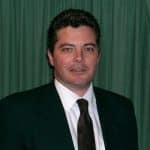
Jerry Spencer
Jerry has an Hons Degree in Soil Science (1988) from Newcastle Upon Tyne University. He then worked as a turf agronomist for the Sports Turf Research Institute (STRI) until 1993.
He gained a Grad Dip in Business Management from UTS in 1999. He has held a number of technical roles for companies such as Arthur Yates (Commercial Technical Manager) and Paton Fertilizers (Organic, turf specialty and controlled release fertiliser) portfolios.
In 2013 he established Gilba Solutions as independent sports turf consultants and turf agronomists. Jerry has written over 100 articles and two books on a wide range of topics such as Turf Pesticides and turfgrass Nutrition which have been published in Australia and overseas.

